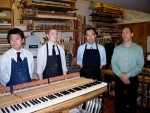Column Name
Title
The piano has many natural enemies. Its seemingly indestructible form is in fact vulnerable to the malign influences of (among others) excessive dryness, excessive humidity, overuse, spilled drinks, and certain modern performance practices. (Thank you, John Cage.) At The Juilliard School, however, the Piano Maintenance Department stands between these noble instruments and oblivion.
Body
The origins of the Piano Maintenance Department are not entirely clear, at least so far as its current constituents are concerned. The technicians, when asked about the department’s history, were united in the belief that the upkeep required of Juilliard’s pianos would have necessitated an in-house piano maintenance organization from the School’s inception. However, none were aware (or let on that they were) of the specific history of the department before the arrival, 25 years ago, of the department’s longest-standing members: Steven Sokolich and Masaru Tsumita. “I would assume,” said Sokolich, “that it’s [existed] as long” as the School has.
As one might expect, piano technicians at Juilliard are highly qualified. However, as in much of the music world, qualifications are primarily informal and performance based. “There are certifications, but they’re not required,” said Richard Short, one of the technicians. However, he added, “everybody was experienced before they worked here.” The ultimate accreditation for piano technicians at Juilliard is the approval of the department head, Tsumita—“He is the certification which is required in this department,” Short said.
Though its members work in many of the same spaces that students and faculty occupy, the Piano Maintenance Department is largely hidden from view because of its size (there are only six piano technicians at Juilliard), and the location of its workshop and offices (which are somewhat hidden in the backstage area of Paul Hall). Moreover, the effectiveness of the department precludes public exposure: well-maintained pianos do not attract the attention that that their poorly-attended peers might.
Public awareness of the department notwithstanding, pianos do not take care of themselves, and preserving all 270 or so of Juilliard’s Steinway pianos—the largest collection of Steinways in one place, the technicians believe—can feel like a Sisyphean endeavor. Short likened the school environment to “a pencil sharpener—it’s like you put a piano in and wood shavings come out.” All sorts of evil can befall a Juilliard piano, explained Sokolich: “We had a broken leg on the concert grand in the theater a couple weeks ago. That’s one example.” He added, “The School is excessively dry in winter, which cracks the wood, which causes many problems for us.”
The course of treatment for an injured piano varies, Short said. “You never know what’s going to be necessary to take care of one of these pianos, so the department has to be ready to do everything.” For more severe damage, “The boss”—Tsumita—“arranges for industrial work to be done outside the shop.”
Severe damage to pianos occurs more frequently than one would hope, and in a setting as frenetic as Juilliard, one of the largest threats to pianos is students. “I wish students wouldn’t put drinks on the piano,” Sokolich said, referring to one of the more cataclysmic events that can transpire in a piano’s lifetime: spillage. “That’s one of the worst things,” Short added. “It’s a disaster, because it goes inside [and] sometimes to really repair it, the piano would have to be completely disassembled and restrung.”
Two other student-related threats to piano well-being are more particular to the habits of pianists at the School. Piano preparation is a frustration technicians occasionally encounter. Sometimes, Sokolich commented, “people take white-out and mark the strings,” and this is not the least of the depredations that result from unauthorized piano preparation. Some of the ways in which pianos can be prepared are permanent, Short explained, and really difficult to correct. “So if people doing prepared piano pieces would consult the Piano Maintenance Department before doing so, we could advise them as to which things don’t hurt the piano,” he said.
When not dealing with damage control, the technicians focus on the more routine tasks at hand: tuning the instruments. Each day, beginning at 6:30 in the morning, the pianos in all the teaching studios and classrooms—about 100 rooms—are tuned. At the same time, four technicians make rounds tuning in the practice rooms. On days when a piano is being used for a concert in one of Juilliard’s six performance spaces, the piano there is tuned for the rehearsal and again for the performance.
How do piano technicians, laboring behind the scenes at Juilliard, cope with a large workload and the aggravation both of repairing easily preventable damage and of being faulted unfairly for the condition of certain pianos? “We eat chocolates,” Sokolich quipped, before correcting himself: “With the exception of me.” Short, however, confessed: “Deliciousness is first.”
On a cheerier note, pianists can take heart, as it appears the urban legend concerning booby-trapped, finger-slicing keyboards is false, at least so far as the pianos at Juilliard are concerned. As Short noted, “I found a quarter wedged between piano keys before. That’s as close to a razor blade as I ever got.”
This is the first installment of "Behind the Scenes," an occasional column that examines the inner-workings of various departments and offices at Juilliard.





